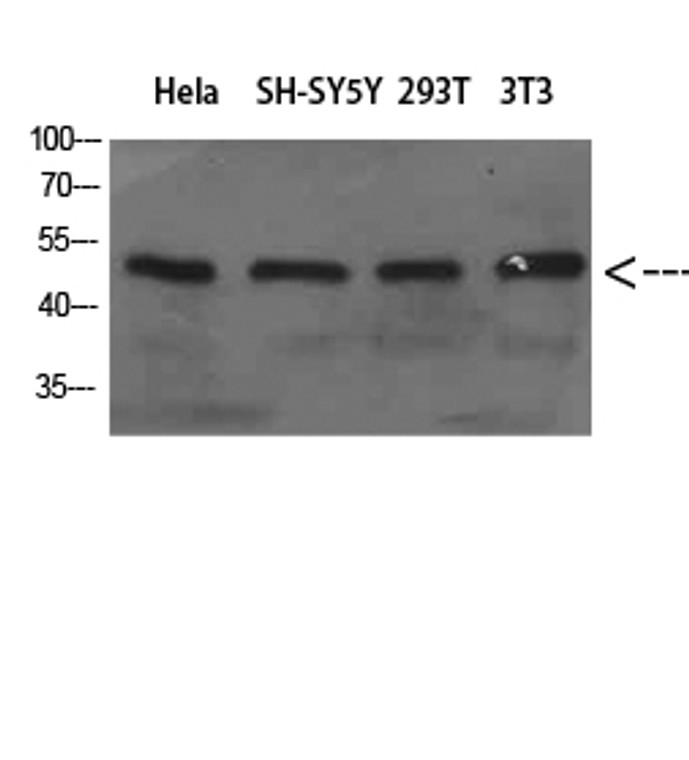| Host: |
Rabbit |
| Applications: |
WB/ELISA |
| Reactivity: |
Human |
| Note: |
STRICTLY FOR FURTHER SCIENTIFIC RESEARCH USE ONLY (RUO). MUST NOT TO BE USED IN DIAGNOSTIC OR THERAPEUTIC APPLICATIONS. |
| Short Description: |
Rabbit polyclonal antibody anti-WD repeat domain phosphoinositide-interacting protein 1 is suitable for use in Western Blot and ELISA research applications. |
| Clonality: |
Polyclonal |
| Conjugation: |
Unconjugated |
| Isotype: |
IgG |
| Formulation: |
Liquid in PBS containing 50% Glycerol, 0.5% BSA and 0.02% Sodium Azide. |
| Purification: |
The antibody was affinity-purified from rabbit antiserum by affinity-chromatography using epitope-specific immunogen. |
| Concentration: |
1 mg/mL |
| Dilution Range: |
WB 1:500-2000ELISA 1:10000-20000 |
| Storage Instruction: |
Store at-20°C for up to 1 year from the date of receipt, and avoid repeat freeze-thaw cycles. |
| Gene Symbol: |
WIPI1 |
| Gene ID: |
55062 |
| Uniprot ID: |
WIPI1_HUMAN |
| Specificity: |
WIPI1 Polyclonal Antibody detects endogenous levels of WIPI1 |
| Immunogen: |
Synthetic Peptide of WIPI1 |
| Function | Component of the autophagy machinery that controls the major intracellular degradation process by which cytoplasmic materials are packaged into autophagosomes and delivered to lysosomes for degradation. Plays an important role in starvation- and calcium-mediated autophagy, as well as in mitophagy. Functions downstream of the ULK1 and PI3-kinases that produce phosphatidylinositol 3-phosphate (PtdIns3P) on membranes of the endoplasmic reticulum once activated. Binds phosphatidylinositol 3-phosphate (PtdIns3P), and maybe other phosphoinositides including PtdIns3,5P2 and PtdIns5P, and is recruited to phagophore assembly sites at the endoplasmic reticulum membranes. There, it assists WIPI2 in the recruitment of ATG12-ATG5-ATG16L1, a complex that directly controls the elongation of the nascent autophagosomal membrane. Together with WDR45/WIPI4, promotes ATG2 (ATG2A or ATG2B)-mediated lipid transfer by enhancing ATG2-association with phosphatidylinositol 3-monophosphate (PI3P)-containing membranes. Involved in xenophagy of Staphylococcus aureus. Invading S.aureus cells become entrapped in autophagosome-like WIPI1 positive vesicles targeted for lysosomal degradation. Also plays a distinct role in controlling the transcription of melanogenic enzymes and melanosome maturation, a process that is distinct from starvation-induced autophagy. May also regulate the trafficking of proteins involved in the mannose-6-phosphate receptor (MPR) recycling pathway. |
| Protein Name | Wd Repeat Domain Phosphoinositide-Interacting Protein 1Wipi-1Atg18 Protein HomologWd40 Repeat Protein Interacting With Phosphoinositides Of 49 KdaWipi 49 Kda |
| Database Links | Reactome: R-HSA-1632852Reactome: R-HSA-381038 |
| Cellular Localisation | Golgi ApparatusTrans-Golgi NetworkEndosomeCytoplasmic VesicleClathrin-Coated VesiclePreautophagosomal Structure MembranePeripheral Membrane ProteinCytoplasmCytoskeletonTrans Elements Of The Golgi And Peripheral EndosomesDynamically Cycles Through These Compartments And Is Susceptible To Conditions That Modulate Membrane FluxEnriched In Clathrin-Coated VesiclesUpon Starvation-Induced AutophagyAccumulates At Subcellular Structures In The Cytoplasm: Enlarged Vesicular And Lasso-Like StructuresAnd Large Cup-Shaped Structures Predominantly Around The NucleusRecruitment To Autophagic Membranes Is Controlled By Mtmr14Labile Microtubules Specifically Recruit Markers Of Autophagosome Formation Like Wipi1Whereas Mature Autophagosomes May Bind To Stable Microtubules |
| Alternative Antibody Names | Anti-Wd Repeat Domain Phosphoinositide-Interacting Protein 1 antibodyAnti-Wipi-1 antibodyAnti-Atg18 Protein Homolog antibodyAnti-Wd40 Repeat Protein Interacting With Phosphoinositides Of 49 Kda antibodyAnti-Wipi 49 Kda antibodyAnti-WIPI1 antibodyAnti-WIPI49 antibody |
Information sourced from Uniprot.org
12 months for antibodies. 6 months for ELISA Kits. Please see website T&Cs for further guidance







